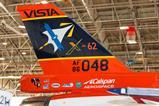Modernisations to the US Air Force (USAF) fleet of Boeing B-52 heavy bombers have been delayed again, with the latest B-52J variant now set to reach initial operating capability (IOC) in 2033.
That upgrade effort covers a variety of onboard systems including new commercial engines, landing struts, electrical power generation and cockpit displays. The current B-52H bombers will separately receive an improved radar system.
The new delays to the modernisation initiative were outlined in the annual report from US Government Accountability Office (GAO) on Pentagon weapons acquisitions programmes, which was released on 17 June.
Two programmes cover the overhaul process: one for the active electronically scanned radar (AESA) upgrade and another for the new engines and associated systems, with the latter programme driving the latest slow down.
“There have been programme delays in part due to funding shortfalls to complete the detailed design,” the GAO says of the B-52 Commercial Engine Replacement Program (CERP).
The USAF will not reach IOC on the re-engined B-52J bombers until 2033, according to the latest GAO assessment. That represents a three-year modification from previous estimates.

CERP aims to replace the B-52’s eight Pratt & Whitney TF33 turbofans with the Rolls-Royce F130, a derivative of the company’s BR725 commercial powerplant. As with the current TF33s, Rolls-Royce is testing the B-52’s new F130 engines in a dual-pod, underwing configuration.
While Rolls-Royce is the propulsion supplier, B-52 prime contractor Boeing is overseeing integration efforts.
“[The programme] has worked with the contractors and submitted budget requests to support critical design review in August 2025 and initial operational capability in mid-fiscal year 2033,” the independent agency says.
The air force currently plans to issue a full production decision after receiving two B-52J test aircraft and completing an 18-month flight test programme.

There are currently 76 B-52Hs in the USAF inventory, with an average age of 62 years, according to Cirium fleets data.
Separately, the B-52 radar modernisation programme (RMP) seeks to replace the current Northrop Grumman APQ‑166 radar with the modified APG-79 Bomber Modernized Radar System (BMRS), an off-the-shelf model from Raytheon.
In 2016, a USAF official described the legacy APQ-166 as “an old radar” with significant reliability issues that result in “flying around with a broken radar a lot”.
The new Raytheon AESA radar, which is currently installed on the US Navy fleet of Boeing F/A-18E/F Super Hornet fighters, is expected to deliver improvements to both reliability and performance.
“The new radar is expected to provide improved functionality and reliability to support both nuclear and conventional B-52H missions while allowing for mission-essential aircraft navigation and weather avoidance,” the GAO report states.
While the RMP uses the “fully mature” APG-79 system, the GAO says the programme is battling cost overruns, with 12.6% margin growth over the initial 2021 cost estimate.
The programme’s schedule also appears poised for delays, with the GAO noting the current USAF timeline calls for a low-rate initial production (LRIP) decision on the first 11 radars to occur before testing is completed on the first production-representative BMRS.
“Our prior work has shown that testing a production prototype after making the production decision increases the risk of costly and time-intensive design changes if the program discovers hardware issues later during integration with legacy systems,” the auditing agency notes.
The current RMP schedule calls for an LRIP decision in March 2025, with prototype testing taking place later that year in June.































